Tourism in Syria
Although it has some of the oldest cities in Western Asia, such as Damascus and Aleppo (a UNESCO World Heritage Site), tourism in Syria has been greatly reduced by the Syrian Civil War and its associated refugee crisis. Many former tourist attractions have been destroyed by shelling; flights by all major airlines have been suspended, and many major hotels have closed. It is estimated that considerable investment will be necessary to revive the country's tourism industry.[1][2][3][4][5]
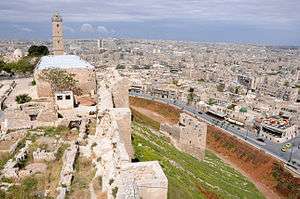
Overview
Before the 2011 crisis
In 2010, tourism had increased considerably compared with the previous year. According to the Tourism Ministry in January 2011, about 6 million foreign tourists visited Syria in 2009; for 2010 the figure was 8.5 million tourists, a 40-percent increase. Tourism revenue was given as 30.8 billion Syrian pounds ($8.4 billion) in 2010, 14 percent of the country's economy.[6] Reports in 2012 from the same Syrian ministry put 2010 tourism industry revenue at $6.5 billion, accounting for 12 percent of the gross domestic product and 11 percent of the nation's employment.[7]
After 2011
Since the beginning of the Syrian Civil War in March 2011, tourism has declined steeply. According to official reports, hotel rooms designed for foreign tourists have been occupied by refugees. In the first quarter of 2012, tourism revenue was about 12.8 billion Syrian pounds ($178 million), compared with 52 billion Syrian pounds ($1 billion) in the first quarter of 2011, and the number of foreign tourists decreased by more than 76 percent in the 2012 quarter. Employment in the tourism industry was down by "nearly two-thirds" in that period.[7] According to UNESCO, five of Syria's six World Heritage Sites have been affected by the civil war.[7][8] In 2012, Syria sent a letter to the United Nations describing the decline of its tourism industry, noting that the country's hotel-occupancy rate had fallen from 90 percent the previous year to 15 percent.[9]
As of 2013, overall Syrian tourism revenue had declined by 94 percent, with Aleppo the worst affected, and the Tourism Minister stated, at the end of September 2013, that 289 tourist destinations had been damaged by conflict since 2011.[10]
By 2015, the movement of tourists had declined by more than 98%. The Syrian Ministry of Tourism claimed that 45,000 tourists visited the country in the first half of 2015, but these figures were disputed by observers, according to the Syrian Economic Forum, which stated that Iranian religious tourism was all that remained.[11] According to a 2015 article in The Telegraph, hotels by beaches in the Mediterranean coast in Tartus and Latakia still received internal tourists and one hotel was "full" in the summer of 2014 and 2015.[12]
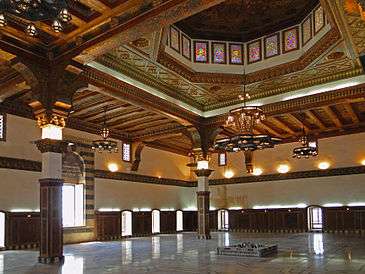
Promotion
Promotion of tourism in Syria is handled by the Syrian Ministry of Tourism. Syria's Tourism ministry maintains an active Facebook page[13] as well as an official Syria Tourism website.[14] In September 2016, Syria's Ministry of Tourism drew criticism from some quarters for releasing a video, "Syria Always Beatiful [sic]," encouraging tourists to visit its beaches. The video spotlighted regions such as Tartus, which remain somewhat peaceful, though Tartus saw an attack resulting in the deaths of over 150 in May 2016.[15]
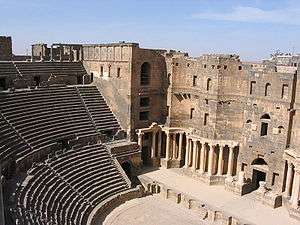
Attractions
.jpg)
UNESCO sites
There are the six UNESCO World Heritage Sites in the country. Twelve other sites submitted to UNESCO are on the organisation's tentative list: Norias of Hama, Ugrarit (Tell Shamra), Ebla (Tell Mardikh), Mari (Tell Hariri), Dura-Europos, Apamée (Afamia), Qasr al-Hayr ach-Charqi, Maaloula, Tartus, Arwad and two sites in the Euphrates valley.[16]
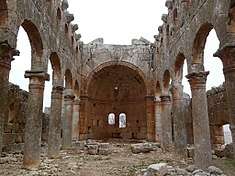
- Ancient City of Aleppo: The Ancient City of Aleppo is the historic city centre of Aleppo, Syria. The Old City of Aleppo, which is composed of the ancient city within the walls and the old cell-like quarters outside the walls approximately holds an area of 350 hectares (860 acres; 3.5 km2), housing about 120,000 residents.[17] Famous for its large mansions, narrow alleys, covered souqs and ancient caravanserais, the Ancient City of Aleppo became a UNESCO World Heritage Site in 1986.[18]

- Bosra: The Ancient city of Bosra is an ancient Roman city. Famed for its Roman theatre, possibly the best preserved in the world, the city also holds many remains of the ancient city such as baths, colonnades and remains of ancient houses and temples.
- Damascus: Is the capital and one of the largest cities in Syria. It is commonly known in Syria as ash-Sham (Arabic: الشام ash-Shām) and nicknamed as the City of Jasmine (Arabic: مدينة الياسمين Madīnat al-Yāsmīn). In addition to being one of the oldest continuously inhabited cities in the world, Damascus is a major cultural and religious centre of the Levant. It's famed for its ancient souks, old city, old Damascene houses and its Umayyad era Mosque, the city also has many remains from the Roman period, such as the Temple of Jupiter, and houses many of the oldest churches in the world, most notably the Chapel of Saint Paul.

- The Dead Cities of northern Syria: The dead cities are a group of 700 abandoned villages in northwest Syria between Aleppo and Idlib. Most villages which date from the 1st to 7th centuries, became abandoned between the 8th and 10th centuries. The settlements feature the well-preserved architectural remains of temples, cisterns, bathhouses and many ancient churches from early Christianity.Important dead cities include the Church of Saint Simeon Stylites, Serjilla and al Bara.
- Krak des Chevaliers and Qal’at Salah El-Din: The Krak de Chevaliers is a Crusader era fortress dating back to the 10th century, and is one of the most important preserved medieval castles in the world. The site was first inhabited in the 11th century by a settlement of Kurdish troops garrisoned there by the Mirdasids; as a result it was known as Hisn al-Akrad, meaning the "Castle of the Kurds". In 1142 it was given by Raymond II, Count of Tripoli, to the Knights Hospitaller. It remained in their possession until it fell in 1271. Together with Qal'at Salah El-Din (Citadel of Saladin), the Krak des Chevaliers is one of the best examples for Crusader era architecture.
- Palmyra: The ancient 2000 BC later Roman colonia of Palmyra is an oasis city in the Syrian desert. The ancient Palmyrenes were renowned merchants who got eormous wealth not only by trading by rare commodities from the east, but also by taking advantage of the city's position as an Oasis, bringing enormous wealth to their city. The Palmyrenes used this wealth to build great monuments, such as the Temple of Bel and the Arch of Triumph, and also to design Greco-Roman and Persian influenced Bas-reliefs of their deceased, many of which are nowadays housed in many of the biggest international museums, which show the craftsmanship of the Palmyrenes and their dedication to their religious rituals.
War tourism
The Syrian conflict is reportedly attracting adventure-seekers.[19] According to retired Israel Defense Forces colonel Kobi Marom, who leads tours of the war zone across the Israeli border, tourists are interested in seeing the conflict and go "crazy" when they learn that they are probably being observed by Al-Qaeda militants.[3][20]
Gallery
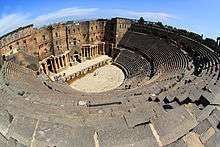
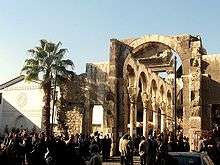
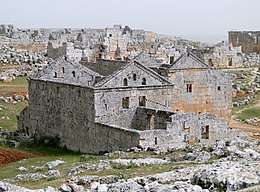 One of the Dead Cities
One of the Dead Cities The Great Mosque of Damascus from the Umayyad era
The Great Mosque of Damascus from the Umayyad era
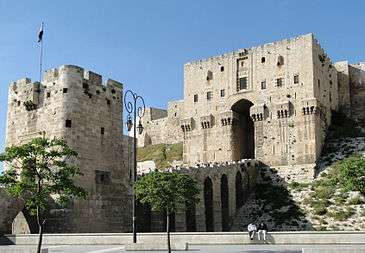
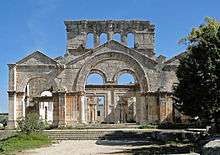 The Church of Saint Simeon Stylites, one of the oldest surviving Byzantine churches
The Church of Saint Simeon Stylites, one of the oldest surviving Byzantine churches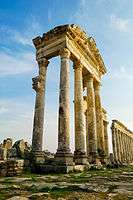
References
| Wikivoyage has a travel guide for Syria. |
- ↑ Syria. "Syria three years on: what for the future of tourism?". Telegraph. Retrieved 15 November 2015.
- ↑ "Travel and Tourism in Syria". Euromonitor.com. Retrieved 15 November 2015.
- 1 2 Hall, John (7 October 2014). "Tourists pose in front of Syrian town under siege by ISIS during US airstrikes | Daily Mail Online". Dailymail.co.uk. Retrieved 15 November 2015.
- ↑ "Syria: flights to Damascus cancelled | euronews, world news". Euronews.com. 29 November 2012. Archived from the original on 17 November 2015. Retrieved 15 November 2015.
- ↑ "Turkish Airlines suspended all flights over Syria". Nationalturk.com. Retrieved 15 November 2015.
- ↑ "Syria sees tourist numbers leap 40% | The National". Thenational.ae. 25 January 2011. Retrieved 15 November 2015.
- 1 2 3 "Conflict decimates Syria tourism: official report". Al Arabia News. 29 August 2012. Retrieved 24 December 2015.
- ↑ "Syrian Tourism Industry: From Boom to Bust – Al-Monitor: the Pulse of the Middle East". Al-Monitor. 24 January 2012. Archived from the original on 17 November 2015. Retrieved 15 November 2015.
- ↑ Reuters Editorial (17 May 2012). "Syria complains to U.N. about tourism downturn amid conflict". Reuters. Retrieved 15 November 2015.
- ↑ "Minister: Syria war costs tourism industry $1.5 billion". Al Arabia News. 30 September 2013. Retrieved 24 December 2015.
- ↑ "Tehran extends a lifeline to Damascus through religious tourism". Syrian Economic Forum. Retrieved 8 July 2016.
- ↑ "It's 'happy holidays in Syria' according to the Assad regime". The Telegraph. Retrieved 8 July 2016.
- ↑ Syria Tourism on Facebook
- ↑ Syria Ministry of Tourism official website
- ↑ Domonoske, Camila (September 5, 2016). "Syria Tourism Ministry: Come For Sunny Beaches, Don't Mind The Civil War". NPR. Retrieved September 25, 2016.
- ↑ UNESCO World Heritage Centre. "Syrian Arab Republic – UNESCO World Heritage Centre". Whc.unesco.org. Retrieved 15 November 2015.
- ↑ bleeker. "Alepposeife: Aleppo history". Historische-aleppo-seife.de. Retrieved 2013-06-10.
- ↑ "eAleppo:Aleppo city major plans throughout the history" (in Arabic).
- ↑ Ben Taub. "War Tourists Flock to Syria's Front Lines". The Daily Beast. Retrieved 15 November 2015.
- ↑ "The Rise of Dark Tourism". The Atlantic. 15 July 2014. Retrieved 15 November 2015.